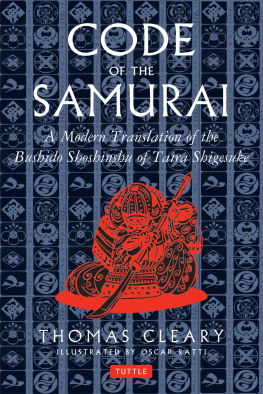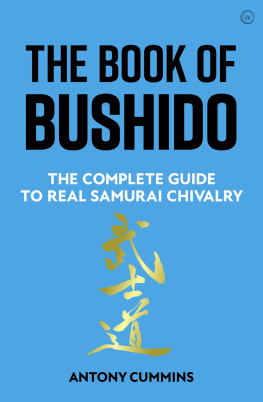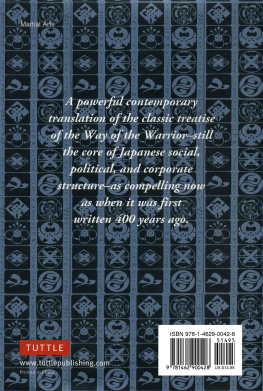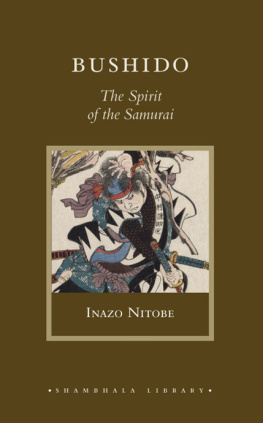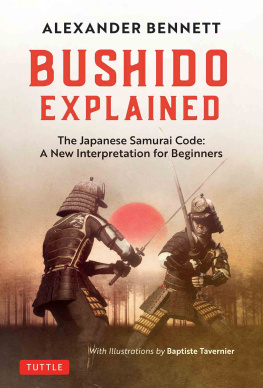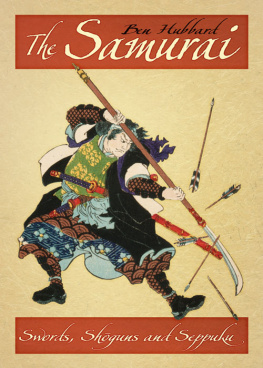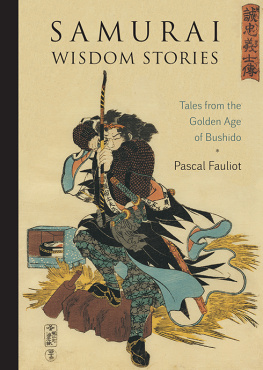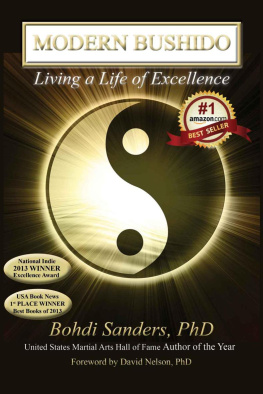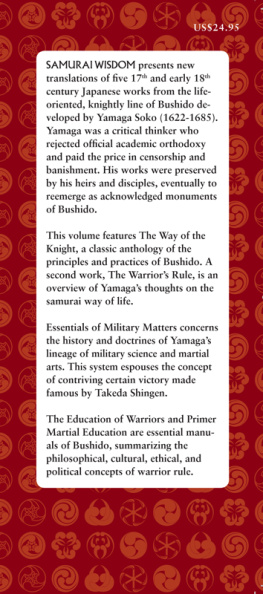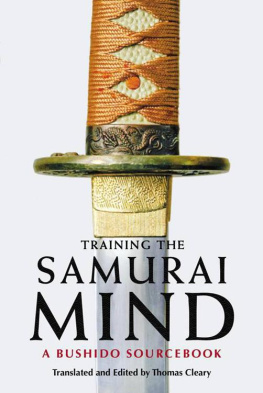Published by Tuttle Publishing, an imprint of Periplus Editions (HK) Ltd.
www.tuttlepublishing.com
Copyright 1999 by Thomas Cleary
All rights reserved. No part of this publication may be reproduced or utilized in any form or by any means, electronic or mechanical, including photocopying, recording, or by any information storage and retrieval system, without prior written permission from the publisher
Library of Congress Cataloging-in-Publication Data
Daidoji, Yuzan 1639-1730
(Budo shoshinshu. English)
(The code of the samurai: a contemporary translation of the
Bushido shoshinshu of Taira Shigesuke / by Thomas Cleary
p. cm.
1. Bushido. 2. SamuraiConduct of Life. I Cleary, Thomas F., 1949-. II. Title.
| BJ971B8D313 1999 | 9852721 |
| 170.440952dc21 | CIP |
ISBN: 978-1-4629-0042-8 (ebook)
Distributed by:
| North America, Latin America Europe | Asia Pacific |
| Tuttle Publishing | Berkeley Books Pte. Ltd. |
| 364 Innovation Drive | 61 Tai Seng Avenue |
| North Clarendon, VT 05759-9436 U.S.A. | #02-12, Singapore 534167 |
| Tel: 1 (802) 773-8930; Fax: (65) 6280-6290 | Tel: (65) 6280-1330 |
| inquiries@periplus.com.sg | Fax: (65) 6280-6290 |
| www.tuttlepublishing.com | inquiries@periplus.com.sg |
| www.periplus.com |
Japan
Tuttle Publishing
Yaekari Building, 3rd Floor
5-4-12 Osaki, Shinagawa-ku, Tokyo 141 0032
Tel: (81) 3 5437-017; Fax: (81) 3 5437-0755
sales@tuttle.co.jp
www.tuttle.co.jp
14 13 12 11 17 16 15 14 13 1104MP
Printed in Singapore
TUTTLE PUBLISHING is a registered trademark of Tuttle Publishing, a division
of Periplus Editions (HK) Ltd.
Code of the Samurai

A Modern Translation of the
Bushido Shoshinsu
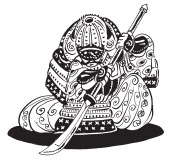
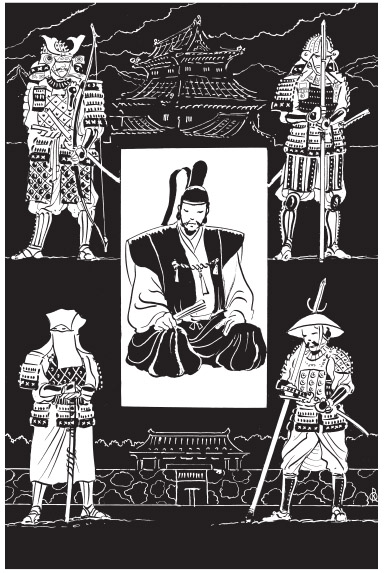
Contents

Introduction
J APANESE CULTURE IS often considered unique, both by foreign visitors and observers and by the Japanese people themselves. This uniqueness is sometimes attributed to Japans geographical situation as an island nation, separated as it is from continental Asia by unusually dangerous waters. The policy of sakoku , or national isolation, adopted by the shoguns from 1639 to 1854 , is also generally considered to have contributed to Japanese cultural insularity; it also helps to explain particular Japanese attitudes toward foreign peoples.
In many respects, whether at home or interacting with outsiders, one of the most powerful cumulative and residual influences of history on the Japanese culture and mentality, even to the present day, has been the extraordinarily long duration of military rule in Japan. The entrenchment of the samurai as the dominant class had profound cultural and psychological effects on the Japanese people. These effects were brought about by the acute changes in society that martial rule effected by force majeure, and also by chronic indoctrination of society subsequently promulgated by the military governments to legitimize their rule ideologically.
The samurai class originated as an offshoot or specialization of the aristocracy. Generally speaking, a polygamous upper class normally produced more children than could be absorbed at the same level of society. The rule of primogeniture, furthermore, meant that only one son inherited the full privileges of his father. These factors created natural and social pressures toward differentiation in the career patterns of the scions of the upper classes.
In Japan, as in Europe and elsewhere, those sons of aristocratic fathers who did not inherit their paternal estate commonly became warriors or monastics. In Japan both of these specializations were originally conceived for the protection of the state; the ancient warriors were first called "samurai" or attendants because they formed the armed guard of the aristocracy. When the samurai eventually took the reins of government from the aristocracy, as an independent class, one way in which they manifested their new status and dignity was to distance themselves from the attendant samurai label and call themselves bushi, warriors or knights.
The ascendancy of the warrior class in Japan was fore-shadowed by its solidification and empowerment, over generations of expansionist wars against the Ainu people, who inhabited Honshu, the main island of Japan, before the modern Japanese settled there. The earlier inhabitants of Kyushu, the southern island of Japan, which seems to have been the main route of ancestral Sino-Korean/Japanese entry into the islands, had been decimated and absorbed comparatively early on in the course of the Japanese settlement. The Ainu of the main island, however, a bear-hunting people, stoutly resisted the expansion of the Japanese for a remarkably long time. The Japanese warrior clans who opposed the Ainu and settled the eastern frontiers thus developed into a stern and hardy breed.
Eventually the Ainu were driven up into Hokkaido, the northernmost of the main islands of modern Japan, leaving the Japanese warrior clans with effective power in eastern Japan. They still exercised this power in the name of the central government, however, as did the warriors in other parts of Japan who administered and policed the outlying lands owned by the increasingly urbanized aristocracy. Once the Ainu had been vanquished from the main island and a degree of national security had been realized, the warrior class and the aristocracy grew further apart in occupational outlook, as the aristocracy focused on cultural development while the warriors handled military and administrative affairs.
Over time the excesses of aristocratic self-indulgence, well documented in parodies of the times, resulted in a certain degree of enervation. At the same time, the responsibilities of the warriors made such demands on them that they in turn demanded a greater share in the revenue from the lands they administered on behalf of the urban aristocracy. These circumstances eventually led to cession of lands to warrior clans, as the most direct form of revenue sharing. Ultimately the land and power held by warrior clans throughout the provinces made possible the establishment of a national military government, operating in parallel with the civil government,which still administered imperial and aristocratic holdings, but more powerful and able to domineer over the latter.
The first military government of Japan, the Bakufu, or Tent Government, was established in 1186in Kamakura, a mountain fastness not far from what is now Tokyo in eastern Japan. This was to be the first of three Tent Governments that ruled Japan from that time until 1868, a period of nearly seven hundred years.

